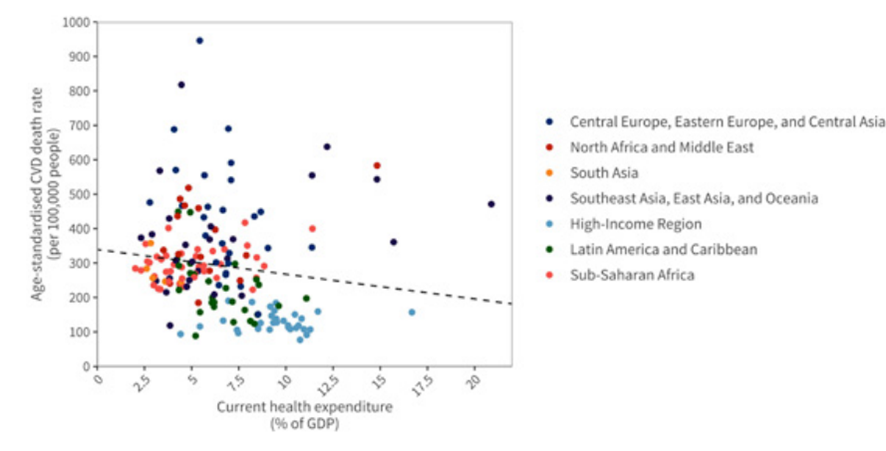The Health Strategist
institute for health strategy, digital health
and continuous transformation
Joaquim Cardoso MSc
Chief Research and Strategy Officer (CRSO),
Editor in Chief and Senior Advisor
June 13, 2023
Key Message(s):
- Countries that spend more on healthcare as a percentage of GDP on average have lower CVD death rates, whereas countries that spend less as a percentage of GDP on average have higher death rates (Figure 7).
- A positive correlation is observed regarding people’s out-of-pocket expenditure. In countries where people spend more out-of-pocket on their healthcare, the CVD death rates are on average higher (Figure 8).
EXCERPT
Many across civil society have long called for countries to invest a minimum of 5% of their Gross Domestic Product (GDP) into health, with the aim of reducing out-of-pocket expenditure and improving service coverage in pursuit of Universal Health Coverage.
This level of investment is consistent with recommendations from WHO[1]; however, there are significant variations between regions in the proportion of countries reaching this target (Table 1).
Table 1 — Proportion of countries spending at least 5% of GDP on health, 2019.[2]
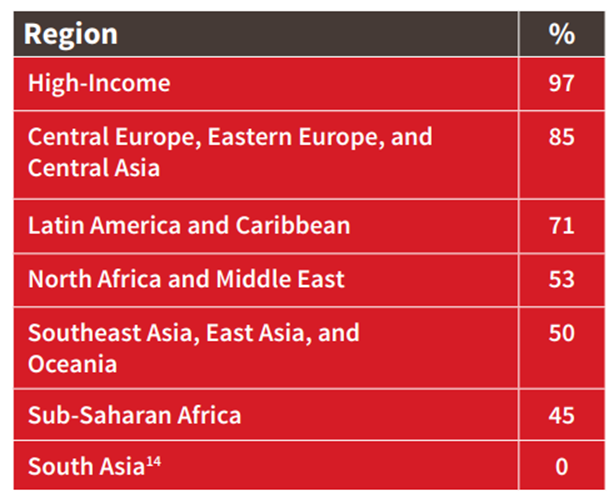
Countries that spend more on healthcare as a percentage of GDP on average have lower CVD death rates, whereas countries that spend less as a percentage of GDP on average have higher death rates (Figure 7).
Figure 7 — National age-standardised cardiovascular disease death rate (per 100,000 people), 2019, by current health expenditure (CHE) as share of national income (GDP).
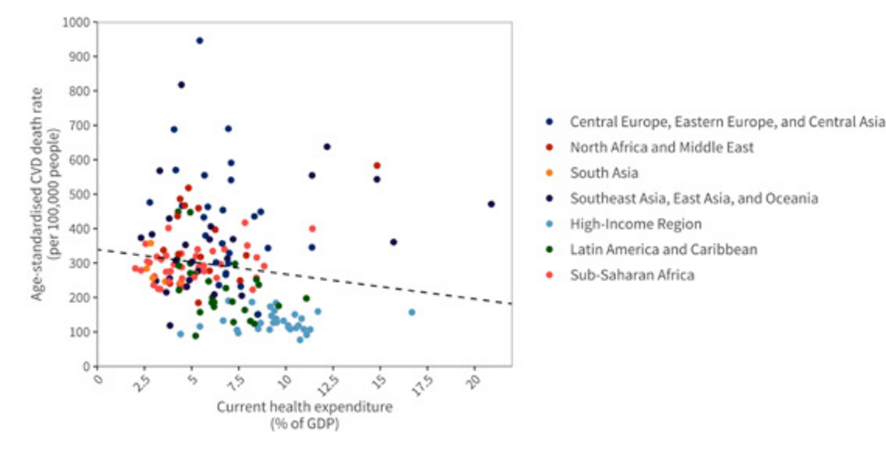
Note: Each dot represents a country, coloured by region. The dashed line shows the negative linear association between CVD death rates and national health expenditure (Pearson’s correlation coefficient = -0.15, p=0.052).
Sources: Institute for Health Metrics and Evaluation (IHME). GBD Compare Data Visualization. Seattle, WA: IHME, University of Washington, 2020. Available from http:// vizhub.healthdata. org/gbd-compare. (18 March 2023); World Health Organization, Global Health Expenditure Database. Available from https:// apps.who.int/nha/ database/Select/ Indicators/en. (13 April 2023)
A positive correlation is observed regarding people’s out-of-pocket expenditure. In countries where people spend more out-of-pocket on their healthcare, the CVD death rates are on average higher (Figure 8).
Figure 8 — National age-standardised cardiovascular disease death rate (per 100,000 people), 2019, by out-of-pocket (OOP) health expenditure as share of current health expenditure (CHE).
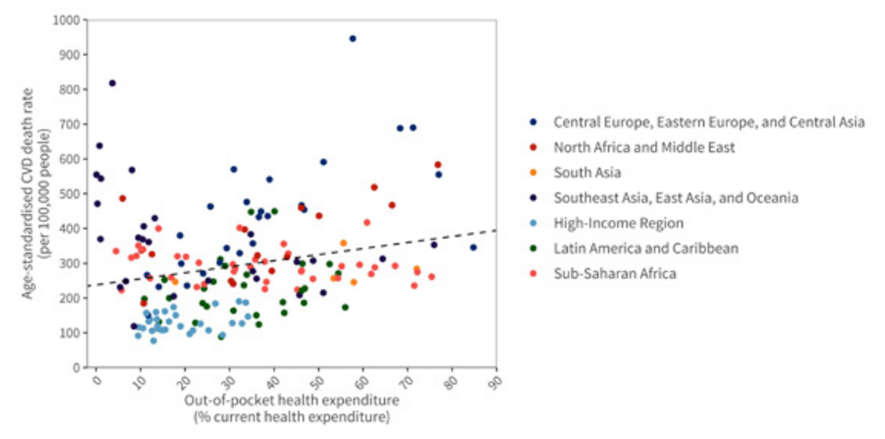
Note: Each dot represents a country, coloured by region. The dashed line shows a positive association between CVD death rates and OOP health expenditure as a share of national health expenditure (Pearson’s correlation coefficient = 0.23, p=0.002).
Source: Institute for Health Metrics and Evaluation (IHME). GBD Compare Data Visualization. Seattle, WA: IHME, University of Washington, 2020. Available from http:// vizhub.healthdata.org/gbdcompare. (18 March 2023); World Health Organization, Global Health Expenditure Database. Available from https://apps.who.int/nha/ database/Select/Indicators/ en. (13 April 2023)
References
[1] World Health Organization. The World Health Report 2010. Available from: https://www.who.int/publications/i/item/9789241564021 (last accessed 10 May 2023).
[2] In South Asia, where no countries reach the 5% target, the percentage of GDP allocated for health expenditure is 2.6% in Bangladesh, 3.6% in Bhutan, 2.9% in India, 4.4% in Nepal and 2.8% in Pakistan.
Original Publication:
Full version
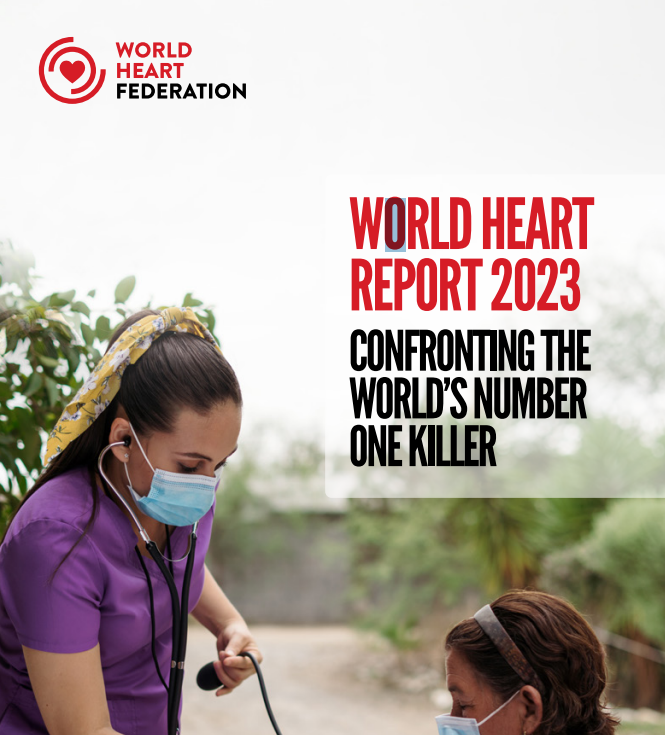
World heart report 2023 — Confronting the world’s number one killer
World Heart Federation (WHF).
Mariachiara Di Cesare, Honor Bixby, Thomas Gaziano, Lisa Hadeed, Chodziwadziwa Kabudula, Diana Vaca McGhie, Jeremiah Mwangi, Borjana Pervan, Pablo Perel, Daniel Piñeiro, Sean Taylor, Fausto Pinto.
Reviewers: Victor Aboyans, Álvaro Avezum, Rick Chazal, Jean-Luc Eiselé, Naomi Herz, Andre Pascal Kengne, Angela Koh, Amam Mbakwem, Jagat Narula, Gregory Roth, Saate Shakil.
Editor: Edward Fox.
The World Heart Report 2023 was made possible through support from Novartis Foundation.




